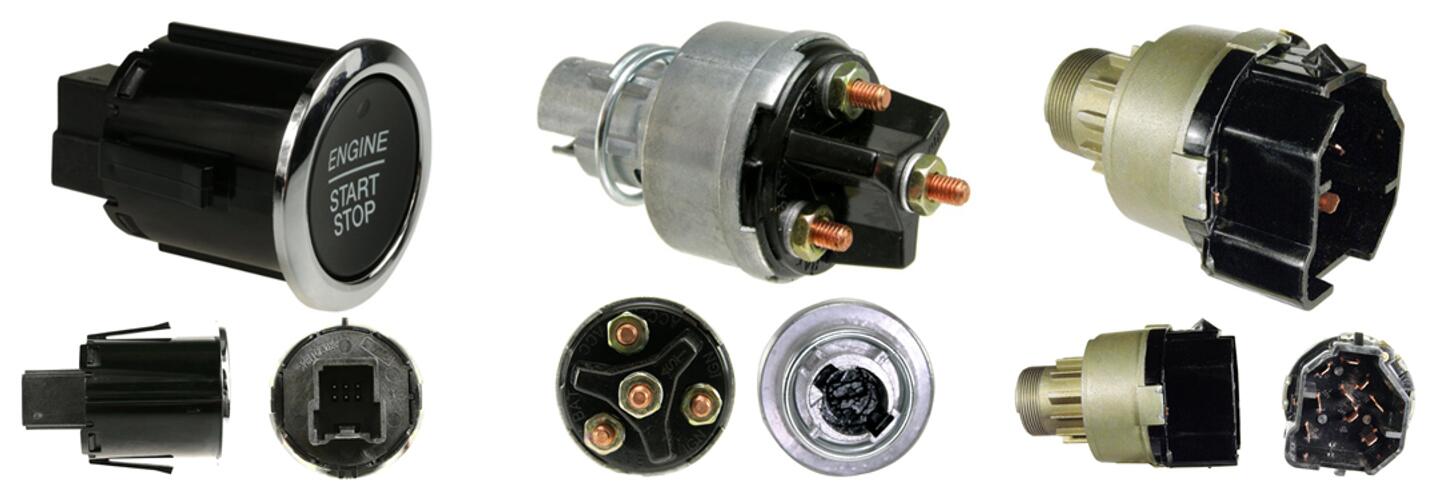
Electronic ignition systems with distributors exist in some old vehicles. The ECU determines the ignition timing (ignition advance angle) based on individual signals output from sensors. It sends signals to the ignition controller. The high voltage is induced in the secondary coil and sent by the distributor to the corresponding cylinder's spark plug to produce sparks.
The ignition system of the Toyota L2JZ-GE engine is of the type that has the distributor, the microcomputer-controlled electronic ignition assembly. The electronic ignition assembly controls the ignition coil.
Here is the working process. The crankshaft angle sensor in the system transmits the crankshaft angle signal Ne. Two camshaft position sensors transmit the camshaft position signals G1 and G2. The intake pressure sensor transmits the intake pressure signal into the engine cylinder. The throttle position sensor transmits the throttle opening signal.
In addition, the water temperature sensor transmits the coolant temperature signal to the ECU of the ignition subsystem. ECU accordingly sends the ignition command signal IGT to the electronic ignition assembly.
The electronic ignition assembly contains a high-power transistor. The component is used to control the on and off of the ignition coil's primary circuit.
After the spark plug finishes its job, the IGF signal of ignition completion is fed back to the microcomputer ECU of the ignition subsystem. Then the engine fuel system is commanded to determine whether to provide fuel injection pulses.
Ford Tempo engine ignition system also has a distributor. The microcomputer controls electronic ignition components, and the electronic ignition components control the ignition coil.
The working process of the system is precisely the same as the Toyota L2JZ-GE engine's ignition system. There are only slight differences in the structure. Ford's electronic ignition components are mounted on the distributor shell.
However, this installation style can cause the electronic ignition assembly to operate incorrectly due to the heat of the engine working. For this reason, some Ford vehicles have the electronic ignition assembly mounted separately on the front wall inside the cab.
There are six types of signals that we should know.
● Profile Ignition Pickup (PIP)
The profile ignition pickup is the signal that the Hall sensor detects the crankshaft position and the engine speed signal. The sensor locates in the distributor. The electronic ignition assembly transmits the signal to the ECU.
Based on the information received, the ECU issues ignition commands to the ignition system. It adjusts the ignition advance angle in terms of signals from other sensors in the car engine.
● Spark out
ECU of the ignition subsystem uses the spark out signal to control the ignition advance angle according to the engine operating conditions. Then it uses the electronic ignition assembly to control the power transistor of the ignition coil.
If this signal is cut off, the engine ignites at the basic ignition advance angle that is not controlled by the ECU.
● Start signal
The start signal is obtained from ignition switch 3. The ignition advance angle is provided according to the engine starting condition.
The signal output sequence of the contact 1 to 3 is: "Start" to "PIP" to "Spark out".
● Switch signal
Turn on the ignition switch. The battery power comes to work. The ignition components are ready for ignition. Turn on the switch again to start the ignition and start the engine.
● Coil signal
When the ignition signal triggers the power transistor, the primary ignition coil is energized and magnetized. When the ignition signal cuts off the power transistor, the secondary coil generates high-voltage electricity to make high-voltage sparks, which ignites the combustible mixture in the corresponding cylinder.
● Ground signal
The electronic ignition system is negatively grounded.
Hyundai Sonata 3.0 car engine ignition system belongs to the external power transistor type. The power transistor installs in the ignition subsystem (outside ECU). It is easy to repair and replace. The control principle of this system is the same as the above engines. We will not repeat it here.
Lexus IUZ-FE engine is the V-8, double overhead camshaft engine. The ignition sequence is 1-8-4-3-6-5-7-2.
The engine uses the ESA electronic ignition advance control system. It consists of ECU, ignition coil, electronic ignition assembly, distributor, ignition relay, spark plug, crankshaft position sensor, camshaft position sensor and other components.
In order to ensure that the spark plug in each cylinder has sufficient ignition energy, the ignition system uses two sets of independent ignition devices on the left and right.
ECU in the ignition subsystem has pre-stored information such as ignition timing at various engine loads and speeds in the ROM.
When the engine is running, the operating conditions are transmitted to the ECU via signals from various sensors such as the throttle position sensor, water temperature sensor, camshaft position sensor, crankshaft sensor and battery voltage.
We can get the ideal ignition advance angle under the working condition after the ECU computes and processes. The transistor T1 is turned on at a certain crankshaft angle before the ideal angle.
The system outputs a high-level ignition signal to the electronic ignition assembly. That is, the IGT signal is "1".
Based on the engine speed, the battery voltage, and the ignition timing of the last ignition, the electronic ignition assembly circuit turns on the triode T2 and the coil's primary winding. It receives the current balance.
The current passage time in the primary winding does not change with the engine speed. This current balance is ensured by the design of the electronic ignition assembly.
If the engine speed increases, the T2 conduction time is longer. The closing angle is larger. Conversely, if the engine speed decreases, the T2 conduction time is shorter, and the closing angle is smaller.
As a result, the system ensures that the ignition energy of the engine is basically unchanged at high and low speeds.
When the crankshaft angle turns to the ignition timing, the ECU immediately instructs the triode T1 to cut off. The IGT signal changes from "l" to "0". At the same time, the electronic ignition assembly cuts off the triode T2 and the primary current in the ignition coil.
So the secondary winding induces the high ignition voltage. The spark plug electrodes can be punctured. The air-fuel mixture in the corresponding cylinder involves in the ignition process.
When the primary current of the ignition coil is cut off, the counter electromotive force is generated, which sends the IGF confirmation signal back to the ECU (The IGF signal is high "1"). This means that the ignition has occurred. The electronic ignition assembly gets involved.
If the ECU does not receive the IGF confirmation signal that ignition has occurred 3 to 5 times in a row, it determines that there is a fault in the ignition system. The ECU then sends a command to the engine fuel system to stop the fuel supply and stop the engine.
When the conduction time of T2 is too long, the primary energization time of the T2 and the ignition coil exceeds the predetermined value. The lockout protection circuit makes these two things cut off.
When the supply voltage is too high, the overvoltage protection also makes T2 cut off. Before the engine ping occurs in the cylinder, the ECU automatically increases the ignition advance angle based on the ignition timing.
The in-cylinder gas pressure reaches the detonation threshold. The slight detonation may occur.
Once the knock sensor finds that the intensity of the detonation in the cylinder exceeds the limit, the ECU immediately sends the command to significantly reduce the ignition advance angle to control the occurrence of strong detonation.
In the next step, the ECU slowly increases the ignition advance angle so that the ignition moment is always maintained at the threshold or a slight degree. The system can achieve the purpose of increasing engine output and reducing engine fuel consumption.

When the engine starts and idles, the detonation suppression system does not work. The ignition advance angle is fixed to a certain value.
With the development of automotive technology, more and more car engines are now using distributorless ignition systems.
Compared with the old ones, the advanced system removes the distributor, so the rotating elements generate no mechanical friction. And the anti-interference ability is stronger.
On the basis of current trends, the design of ignition systems is increasingly oriented towards low sparks loss and fuel economy. Distributorless ignition systems are becoming more and more popular. Distributors are more often found in old and used cars.
 Lauritz Carolsfeld
Lauritz Carolsfeld  November 12, 2021
November 12, 2021


